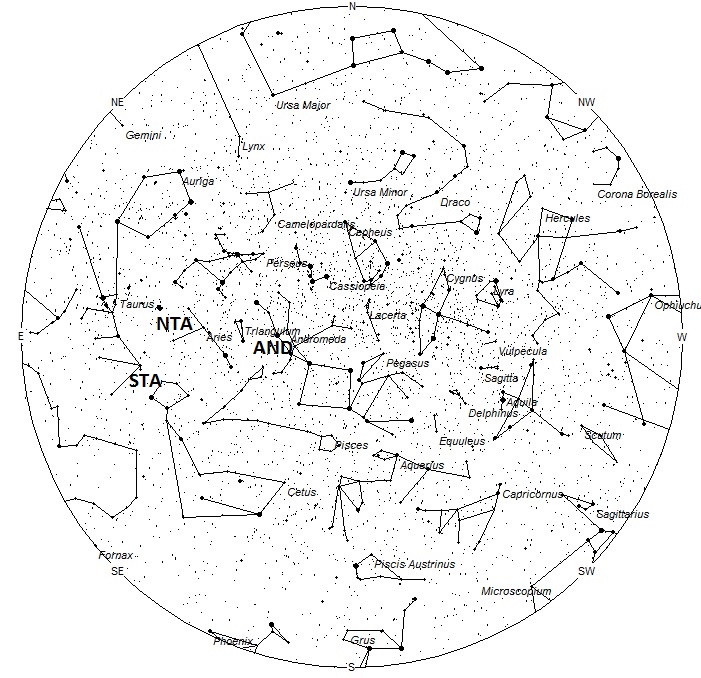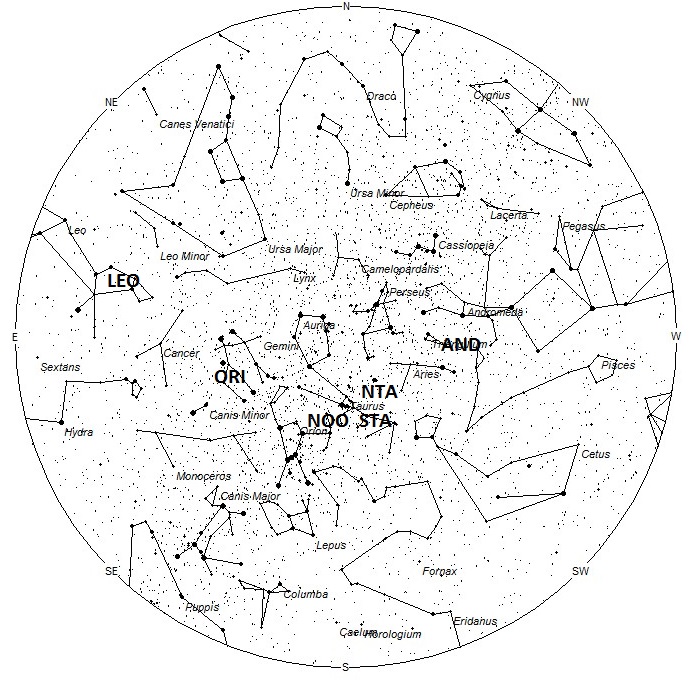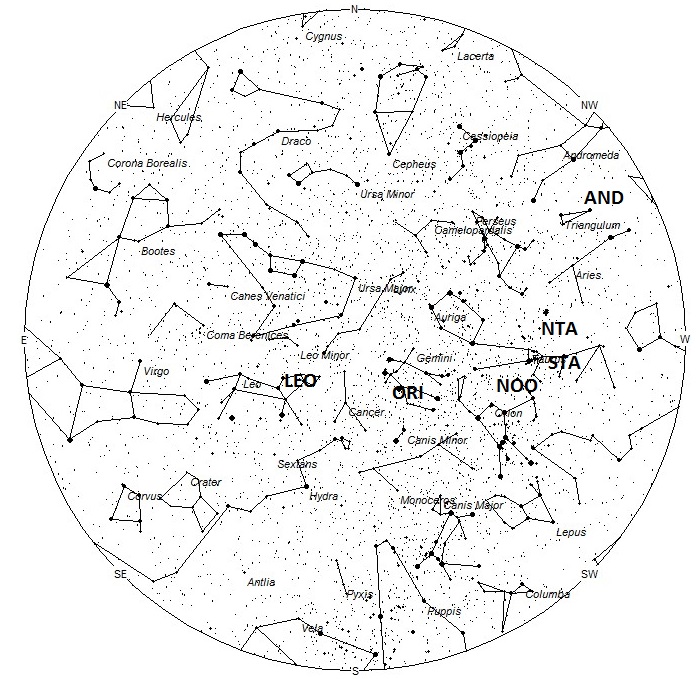During this period the moon reaches its first quarter phase on Saturday November 9th. At this time the half-illuminated moon will lie 90 degrees east of the sun and will set near 2300 (11pm) local standard time as seen from mid-northern latitudes. This will leave the more active morning hours totally free of interfering moonlight. As the week progresses, the waxing gibbous moon will set later each night. By the end of the period the bright moon will lie above the horizon most of the night. The estimated total hourly meteor rates for evening observers this week is near 4 for observers located in the northern hemisphere and 3 for those viewing south of the equator. For morning observers the estimated total hourly rates should be near 20 as seen from mid-northern latitudes and near 14 for observers viewing from tropical southern latitudes. Evening rates are lower than normal due to interfering moonlight. The actual rates will also depend on factors such as personal light and motion perception, local weather conditions, alertness and experience in watching meteor activity. Note that the hourly rates listed below are estimates as viewed from dark sky sites away from urban light sources. Observers viewing from urban areas will see less activity as only the brightest meteors will be visible from such locations.
The radiant (the area of the sky where meteors appear to shoot from) positions and rates listed below are exact for Saturday night/Sunday morning November 9/10. These positions do not change greatly day to day so the listed coordinates may be used during this entire period. Most star atlases (available at science stores and planetariums) will provide maps with grid lines of the celestial coordinates so that you may find out exactly where these positions are located in the sky. A planisphere or computer planetarium program is also useful in showing the sky at any time of night on any date of the year. Activity from each radiant is best seen when it is positioned highest in the sky, either due north or south along the meridian, depending on your latitude. It must be remembered that meteor activity is rarely seen at the radiant position. Rather they shoot outwards from the radiant so it is best to center your field of view so that the radiant lies at the edge and not the center. Viewing there will allow you to easily trace the path of each meteor back to the radiant (if it is a shower member) or in another direction if it is a sporadic. Meteor activity is not seen from radiants that are located below the horizon. The positions below are listed in a west to east manner in order of right ascension (celestial longitude). The positions listed first are located further west therefore are accessible earlier in the night while those listed further down the list rise later in the night.
The following sources of meteoric activity are expected to be active this week:
The Andromedids (AND) are active from a radiant located at 01:32 (023) +31, which lies on the Pisces/Triangulum border, very close to the spot occupied by the famous “Pinwheel Galaxy” in Triangulum. This position also lies 4 degrees northwest of the 3rd magnitude star Alpha Trianguli. This is a famous shower that produced some brilliant displays during the 19th century. Since then the main orbit of the particles from comet 3D/Biela have moved away from the Earth. Still, remnants may be seen from October 26 through November 20 with maximum activity occurring on November 8. These meteors are best seen near 2300 (11pm) local standard time (LST) when the radiant lies highest above the horizon. Rates would most likely be less than 1 per hour no matter your location. With an entry velocity of 19 km/sec., the average Andromedid meteor would be of slow velocity.
The Northern Taurids (NTA) are active from a large radiant centered at 03:48 (057) +22, which lies in western Taurus, only 2 degrees south of the famous naked eye star cluster known as the Pleiades. The radiant is best placed near 0100 LST, when it lies highest above the horizon. Rates should be near 3 per hour as seen from the northern hemisphere and 2 as seen from south of the equator
The center of the large Southern Taurid (STA) radiant is currently located at 03:56 (059) +15. This position lies in western Taurus, 8 degrees west of the orange first magnitude star known as Aldebaran (Alpha Tauri). These meteors may be seen all night long but the radiant is best placed near 0100 LST when it lies on the meridian and is located highest in the sky. Rates at this time should be near 2 per hour regardless of your location. With an entry velocity of 29 km/sec., the average Southern Taurid meteor would be of slow velocity.
Late in this period it may be possible to spot some activity from the November Orionids (NOO), not to be confused with the October Orionids (ORI), which are also currently active from southern Gemini. The radiant for the November Orionids is currently located at 05:04 (076) +13, which lies in northwestern Orion directly between the bright stars Aldebaran (Alpha Tauri) and Bellatrix (Gamma Orionis). These meteors are best seen near 0200 LST when the radiant lies highest above the horizon. Current rates would be less than 1 per hour no matter your location. With an entry velocity of 44 km/sec., most activity from this radiant would be of medium speed.
The Orionids (ORI) are still active from a radiant at 07:24 (111) +16, which places it in southern Gemini, 2 degrees west of the faint star known as Lambda Geminorum. This area of the sky is best placed in the sky near 0400 LST, when it lies highest above the horizon. Rates this week should still be near 2 per hour no matter your location. With an entry velocity of 67 km/sec., most activity from this radiant would be of swift speed.
The Leonids (LEO) are active from a radiant located at 09:56 (149) +24. This position is located in northwestern Leo, 2 degrees east of the 3rd magnitude star known as Algenubi (Epsilon Leonis). This area of the sky is best placed in the sky during the last hour before dawn, when it lies highest above the horizon in a dark sky. Current hourly rates should be near 2 as seen from the northern hemisphere and 1 as seen from south of the equator. With an entry velocity of 71 km/sec., most activity from this radiant would be of swift speed.
As seen from the mid-northern hemisphere (45N) one would expect to see approximately 11 sporadic meteors per hour during the last hour before dawn as seen from rural observing sites. Evening rates would be near 3 per hour. As seen from the tropical southern latitudes (25S), morning rates would be near 7 per hour as seen from rural observing sites and 2 per hour during the evening hours. Locations between these two extremes would see activity between the listed figures. Evening rates are reduced due to moonlight.
The table below presents a list of radiants that are expected to be active this week. Rates and positions are exact for Saturday night/Sunday morning except where noted in the shower descriptions.
| SHOWER | DATE OF MAXIMUM ACTIVITY | CELESTIAL POSITION | ENTRY VELOCITY | CULMINATION | HOURLY RATE | CLASS |
| RA (RA in Deg.) DEC | Km/Sec | Local Standard Time | North-South | |||
| Andromedids (AND) | Nov 08 | 01:32 (023) +31 | 19 | 23:00 | <1 – <1 | III |
| Northern Taurids (NTA) | Nov 11 | 03:48 (057) +22 | 29 | 01:00 | 3 – 2 | II |
| Southern Taurids (STA) | Oct 10 | 03:56 (059) +15 | 29 | 01:00 | 2 – 2 | II |
| Nov. Orionids (NOO) | Nov 29 | 05:04 (076) +13 | 44 | 02:00 | <1 – <1 | II |
| Orionids (ORI) | Oct 22 | 07:24 (111) +16 | 67 | 04:00 | 2 – 2 | I |
| Leonids (LEO) | Nov 18 | 09:56 (149) +24 | 71 | 07:00 | 2 – 1 | I |
 American Meteor Society
American Meteor Society



I would just like to point out that Saturday is not Nov. 10th, it is in fact Nov. 9th. 😀
You’re right. I didn’t catch that. Hope I can fix it!